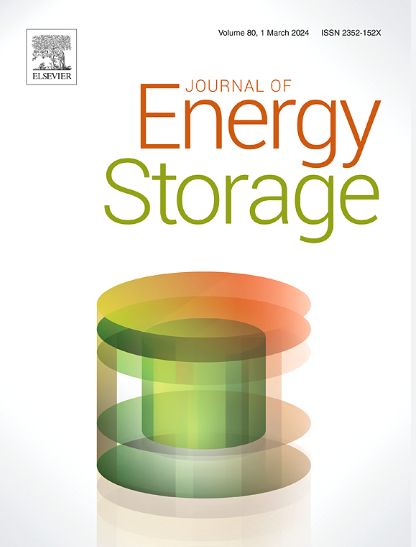Coordinated power sharing in a low voltage direct current microgrid with photovoltaic and hybrid energy storage system for two-wheeler electric vehicle charging
IF 8.9
2区 工程技术
Q1 ENERGY & FUELS
引用次数: 0
Abstract
The increasing popularity of electric vehicles (EVs), driven by technological advances and a heightened awareness of environmental sustainability, has led to the commercial production of solar-powered battery charging stations. This shift is further supported by the declining costs of photovoltaic (PV) systems. This study presents a solar-powered EV charging station equipped with a 100 V Direct Current (DC) bus, incorporating a PV system and a hybrid energy storage system (HESS). The HESS integrates batteries and supercapacitors to efficiently regulate charging demand changes and stabilize local loads. A unique State of Charge (SoC)-based current-sharing coefficient and voltage error feed-forward loop facilitate accurate DC bus voltage regulation, reducing battery stress by using supercapacitors for transient load management. The proposed system achieves DC bus voltage regulation within 30–45 ms, reducing undershoot and overshoot by 74.3 % and 78.9 %, respectively, compared to conventional methods. Additionally, the voltage ripple is minimized to 0.9 %, representing an 80.0 % improvement. Two two-wheeler EVs are charged using multi-rate constant current charging, which optimizes SoC levels and enhances the State of Health (SoH) of EV batteries. The power management system is meticulously assessed under various operating conditions, reflecting different levels of PV power availability and load demands. The model is simulated using MATLAB/SIMULINK and validated through OPAL-RT OP-4510 real-time simulator, with results confirming the system's efficiency, stability, and reliability.
基于光伏与混合储能系统的低压直流微电网两轮电动车充电协调电力共享
在技术进步和环境可持续性意识的推动下,电动汽车(ev)日益普及,导致了太阳能电池充电站的商业化生产。光伏(PV)系统成本的下降进一步支持了这种转变。本研究提出了一种配备100 V直流(DC)总线的太阳能电动汽车充电站,结合了光伏系统和混合储能系统(HESS)。HESS集成了电池和超级电容器,有效地调节充电需求变化,稳定本地负载。独特的基于荷电状态(SoC)的电流共享系数和电压误差前馈回路有助于精确的直流母线电压调节,通过使用超级电容器进行瞬态负载管理来减少电池压力。该系统在30-45 ms内实现直流母线电压调节,与传统方法相比,过调量和过调量分别减少了74.3%和78.9%。此外,电压纹波被最小化到0.9%,代表80.0%的改进。两辆两轮电动汽车采用多倍率恒流充电,优化了电池的SoC水平,提高了电池的健康状态(SoH)。电源管理系统在各种运行条件下进行了细致的评估,反映了不同水平的光伏电力可用性和负载需求。利用MATLAB/SIMULINK对模型进行了仿真,并通过OPAL-RT OP-4510实时仿真器对模型进行了验证,结果验证了系统的效率、稳定性和可靠性。
本文章由计算机程序翻译,如有差异,请以英文原文为准。
求助全文
约1分钟内获得全文
求助全文
来源期刊

Journal of energy storage
Energy-Renewable Energy, Sustainability and the Environment
CiteScore
11.80
自引率
24.50%
发文量
2262
审稿时长
69 days
期刊介绍:
Journal of energy storage focusses on all aspects of energy storage, in particular systems integration, electric grid integration, modelling and analysis, novel energy storage technologies, sizing and management strategies, business models for operation of storage systems and energy storage developments worldwide.
 求助内容:
求助内容: 应助结果提醒方式:
应助结果提醒方式:


